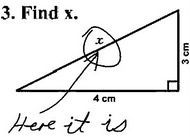How to avoid sounding like an Amurrrrican when you pronounce the letter "R."
I've been conducting the Triangle Jewish Chorale for fourteen years and still struggle with "American R" in our Hebrew and Yiddish songs. The basic problem: our native language, English, has no guttural or rolled consonants, so they are difficult for some people to hear, much less pronounce.
I tell my singers I'll accept either
- The "German" or "French" guttural R, or
- The "Spanish" flipped/rolled R.
By the way, here is an interesting explanation of the way the R prononunciation of modern Hebrew came about:
The Zionist Eliezer ben Yehuda - though an Ashkenazi Jew in Czarist Russia - based his Standard Hebrew on the Sephardic dialect originally spoken in Spain, and therefore recommended an alveolar [forward, rolled] R.Isn't that odd?
But as the first waves of Jews to resettle in the Holy Land were northern Ashkenazi, they came to speak Standard Hebrew with their preferred uvular articulation [guttural, gargled] as found in Yiddish or modern standard German, and it gradually became the most prestigious pronunciation for the language.
The modern State of Israel has Jews whose ancestors came from all over the world, but nearly all of them today speak Hebrew with a uvular R because of its modern prestige and historical elite status.
How to make the flipped or rolled (Spanish) R:
Put your tongue in the "D" position (bend the tip up and touch just behind your top gums). Now lower it a tiny bit so there is an airspace above it and move it quickly toward the back of your mouth. That's it.
If you try this in the word "practice," PDACTICE PDACTICE PDACTICE, faster and faster, you'll get it.
OR - I found this exercise online:
- Say the word butter, then say the word ladder.
- Feel your tongue "flip up" during the second syllable, barely touching the ridge above and behind the top row of teeth, almost touching the roof your mouth.
- Now say each word faster, "Butter, Butter, Butter, Ladder, Ladder, Ladder".
- You may decide one word works better for you. Eventually you'll get it.
- Try saying "Dracula" and see if it helps you roll the R by putting a D in front of it. Touch the tip of your tongue to the bottom of your two top front teeth. Then when say "Dracula" and notice the tongue moves loosely but quickly from the tips of your teeth to the roof of your mouth.
- Practice using the R in word-initial combinations as "dr-", "tr-", "br-", "pr-" - it is much easier to pronounce in those positions. Once you can do that, work on dropping the initial consonant.
Singing teachers often recommend repeating Tee-Dee-Va Tee-Dee-Va Tee-Dee-Va rapidly to strengthen and loosen up the correct muscles.
How to make the guttural (German, French, Yiddish, Hebrew) R:
This is called a uvular consonant, the tongue action is toward the back of your mouth.
I suggest putting your tongue in the "G" position, then drop the tongue a tiny bit to create an airspace above the back of the tongue and blow air through the space.
You can also try "gargling" without any liquid in your mouth. And lastly, here's an exercise I found online:
- Open your mouth and carefully enunciate the sound K, several times.
- Pay attention to where in your throat the K sound is made. We'll call this the K place.
- Begin slowly closing your throat, as if to keep from swallowing a mouthful of liquid, until you can almost feel the K place. Your throat should be only partially constricted.
- Tense the muscles around the K place.
- Gently push air through your partially constricted throat.
- Practice saying Ra-Ra-Ra (where R = steps 4-6) every day.
Technorati Tags: pronunciation, american, yiddish, hebrew, spanish, french, german



 A few of my daughter
Melina's great posts:
A few of my daughter
Melina's great posts:








2 Comments:
I never thought that written text could be used so effectively to describe how to make a sound, but this seems to do it for me.
I think one problem with pronouncing "R"s incorrectly in Yiddish and Hebrew stems from the fact that it is ingrained in our brains to pronounce it that way when we read an "R."
Maybe we need to replace all of the Rs in our music with something that reminds us of the sound we need to make. I suggest a letter that looks something like the uvula. Something like the following...
) (
(_)
(Sorry, I am limited by graphics)
Thanks Mike! I agree, I think the American R and the Spanish R and the French/Yiddish R are so different it's confusing to use the same symbol.
Post a Comment
<< Home